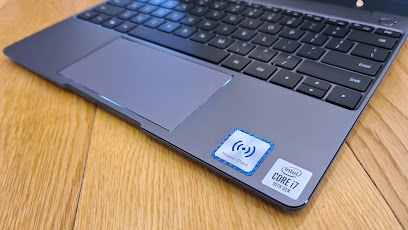In just a few months I've gone from never having even touched a Huawei laptop to being absolutely enamoured with them.
Not so long ago I reviewed the Matebook X Pro and was quite frankly blown away. It was powerful, feature-packed, with a fantastic build quality and a wonderful display.
So what happens when you take all that and make it a bit smaller?...
If you're thinking, "Wait... Haven't I seen that somewhere before?" the answer is you have and you haven't. At first glance and with no reference points to judge scale, you could be forgiven for confusing this picture of the Huawei Matebook 13 with images of the Matebook X Pro. I can assure you, the smaller model is a couple of centimetres more narrow.
But here's the thing; I've used both devices and I'm really struggling to detect the Matebook 13's limitations.
The main reason for this is the differences between Huawei's flagship notebook and this pared-down version are not really performance-related. Both devices combine Intel's 10thGen i7-10510U processor, a generous 16GB of RAM with a combination of Intel's integrated graphics and a dedicated NVIDIA GeForce MX250 card. So in essence, the brains are the same. Not only does that latest CPU and hefty RAM combo keep things running smoothly and quickly but Huawei's ability to auto-switch between graphics cards conserves battery and allows the raw computing power to be diverted to where it's needed most.
As I say, this high-end setup is the same for both the X Pro and the Matebook 13 and because the demands from the Matebook 13's display aren't as great, potentially the smaller device may even perform more powerfully. I've certainly encountered no shortfalls no matter what I've thrown at it; audio editing, streaming, multi-tasking - you name it.
So about that display... While it's true the Matebook 13 sports an IPS LCD screen as opposed to the X Pro's LTPS version, the difference in resolution and brightness is pretty hard to pick up. Is there really much of a gap between the 2K and 3K FullView displays? Not that I can tell. Both offer ten-point touch capability, both let you screenshot with a three-finger swipe and most importantly of all, as far as I'm concerned anyway, both have a 3:2 aspect ratio. I've decided this is definitely my preferred shape for a laptop screen as it just seems to provide so much more desktop area to place different windows onto. Touch-wise, I've found the display to be super accurate and combined with the wide, responsive and clicky touchpad, I haven't felt the need to plug in a mouse, even when editing.
Watching Netflix and other video is great - not only is the picture quality excellent but the dual speaker array performs well too. Unlike the X Pro, there are only two speakers, not four but audio is clear, fairly loud and the stereo separation is top notch. I'm not suggesting this would be my preferred device for listening to my favourite Spotify playlist - not through the speakers anyway. But in terms of binge-watching a few episodes of Ozark in bed, awesome.
The twin microphone array on the Matebook 13 doesn't quite match up to the quad system on the X Pro either. Video calls are absolutely fine without blowing anybody away with sound and video clarity - although thanks to the 2x2 MIMO dual WiFi antennae, connectivity is extremely reliable.
There are two other fantastic features the Matebook 13 shares with the X Pro; the power button fingerprint reader and Huawei Share. While we're all used to securing our smartphones with a fingerprint, it's a relatively new feature on laptops. The great thing about the sensor on this device is it works straight away; even though the laptop still takes a few seconds to boot up, it reads your fingerprint the moment you push the power button so you don't have to log in again, instantly bypassing the welcome screen. So cool.
Huawei Share is even cooler. This is the feature that enables you to mirror your Huawei phone on the Matebook 13's screen with a single tap. This doesn't require an internet connection as it uses NFC instead. Not only can you keep an eye on notifications from your phone but you can swipe files and photos between both devices wirelessly. It's like a magic trick.
I can't stress enough how well this laptop runs. There's basically no bloatware pre-installed, only the PC Manager app which does a brilliantly quiet job of keeping all your drivers up to date. The edge-to-edge keyboard has good travel and isn't at all cramped given the small size of the device and the bezels around the screen, while not quite as invisible as those of the X Pro, are still pretty skinny for a laptop. This is a powerful computer with excellent battery-life, small enough to fit in any briefcase, satchel or schoolbag - even handbags. And because it charges via USB-C, you can use the same charger for your phone as well.
I'd prefer to see a standard USB-A port alongside the two USB-C's but I guess you can't have everything. That's why they invented docks and adapters I guess.
One port short; that's basically my only gripe with this little beauty. It's a joy to use and I'd recommend it to anyone.
Click here for more information on the Huawei Matebook 13 2020.




No comments:
Post a Comment